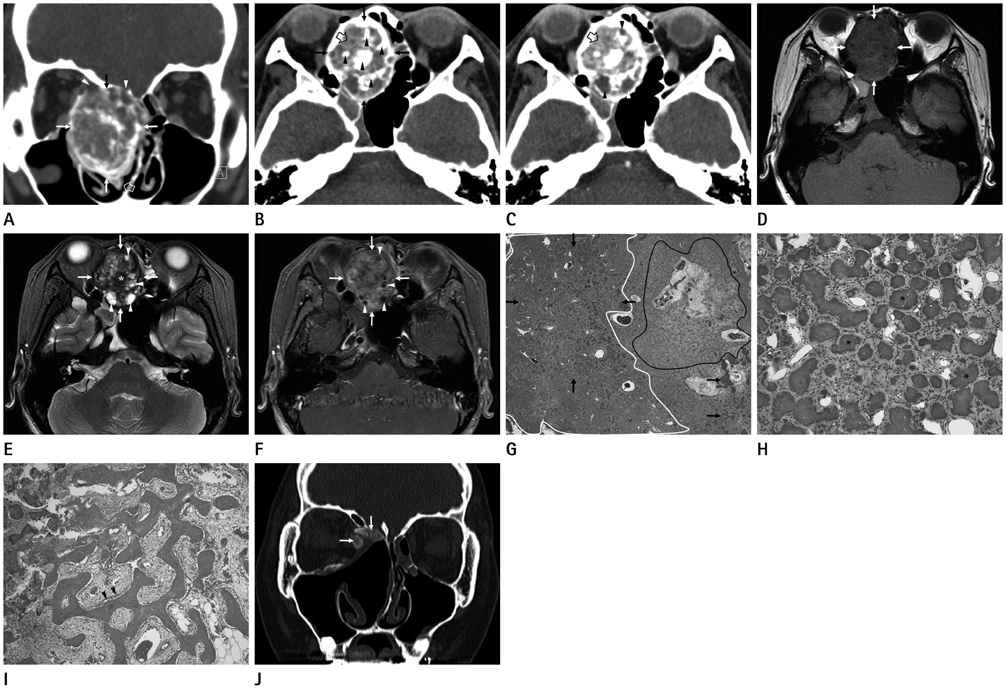J Korean Soc Radiol.
2013 Jun;68(6):449-452. 10.3348/jksr.2013.68.6.449.
CT and Magnetic Resonance Imaging Findings of Psammomatoid Juvenile Ossifying Fibroma of the Middle Turbinate: A Case Report
- Affiliations
-
- 1Department of Radiology, Dongsan Medical Center, Keimyung University School of Medicine, Daegu, Korea. sklee@dsmc.or.kr
- 2Department of Pathology, Dongsan Medical Center, Keimyung University School of Medicine, Daegu, Korea.
- KMID: 2002894
- DOI: http://doi.org/10.3348/jksr.2013.68.6.449
Abstract
- Ossifying fibroma of the middle turbinate is extremely rare. We report a case of psammomatoid juvenile ossifying fibroma (PsJOF) of the middle turbinate in an 18-year-old adolescent female along with its CT, MRI and pathologic features. PsJOF of the middle turbinate may present a well-demarcated, expansile, solidly enhancing mass with focal bony destruction, which may mimic various benign and malignant neoplasms of the sinonasal area. A combination of clinical, imaging and pathologic findings is prerequisite for establishing an accurate diagnosis.
MeSH Terms
Figure
Reference
-
1. Caylakli F, Buyuklu F, Cakmak O, Ozdemir H, Ozluoglu L. Ossifying fibroma of the middle turbinate: a case report. Am J Otolaryngol. 2004; 25:377–378.2. Galvan O, Gassner EM, Neher A, Gunkel AR. Fibro-osseous lesion of the middle turbinate: ossifying fibroma or fibrous dysplasia? J Laryngol Otol. 2007; 121:1201–1203.3. Pata YS, Ekici ID, Cihangiroğlu M, Doğan M, Koçak I. Ossifying fibroma of the inferior turbinate. Kulak Burun Bogaz Ihtis Derg. 2011; 21:163–166.4. Danielides V, Ingels K, Patrikakos G, de Wilde PC. Aggressive psammomatoid ossifying fibroma of the inferior turbinate and lateral nasal wall. Acta Otorhinolaryngol Belg. 2003; 57:87–90.5. Marvel JB, Marsh MA, Catlin FI. Ossifying fibroma of the mid-face and paranasal sinuses: diagnostic and therapeutic considerations. Otolaryngol Head Neck Surg. 1991; 104:803–808.6. Lund VJ. Ossifying fibroma. A case report. J Laryngol Otol. 1982; 96:1141–1147.7. Bertrand B, Eloy P, Cornelis JP, Gosseye S, Clotuche J, Gilliard C. Juvenile aggressive cemento-ossifying fibroma: case report and review of the literature. Laryngoscope. 1993; 103:1385–1390.8. London SD, Schlosser RJ, Gross CW. Endoscopic management of benign sinonasal tumors: a decade of experience. Am J Rhinol. 2002; 16:221–227.9. Post G, Kountakis SE. Endoscopic resection of large sinonasal ossifying fibroma. Am J Otolaryngol. 2005; 26:54–56.10. Han MH, Chang KH, Lee CH, Seo JW, Han MC, Kim CW. Sinonasal psammomatoid ossifying fibromas: CT and MR manifestations. AJNR Am J Neuroradiol. 1991; 12:25–30.
- Full Text Links
- Actions
-
Cited
- CITED
-
- Close
- Share
- Similar articles
-
- An expanded juvenile ossifying fibroma in maxillary sinus: a case report
- Juvenile psammomatoid ossifying fibroma of the maxilla
- A case report of juvenile active ossifying fibroma
- Juvenile Ossifying Fibroma: A Clinicopathologic Study of 8 Cases and Comparison with Craniofacial Fibro-osseous Lesions
- A Case of Psammomatoid Ossifying Fibroma of Sinonasal Tract Presenting with a Facial Deformity and Choanal Atresia


